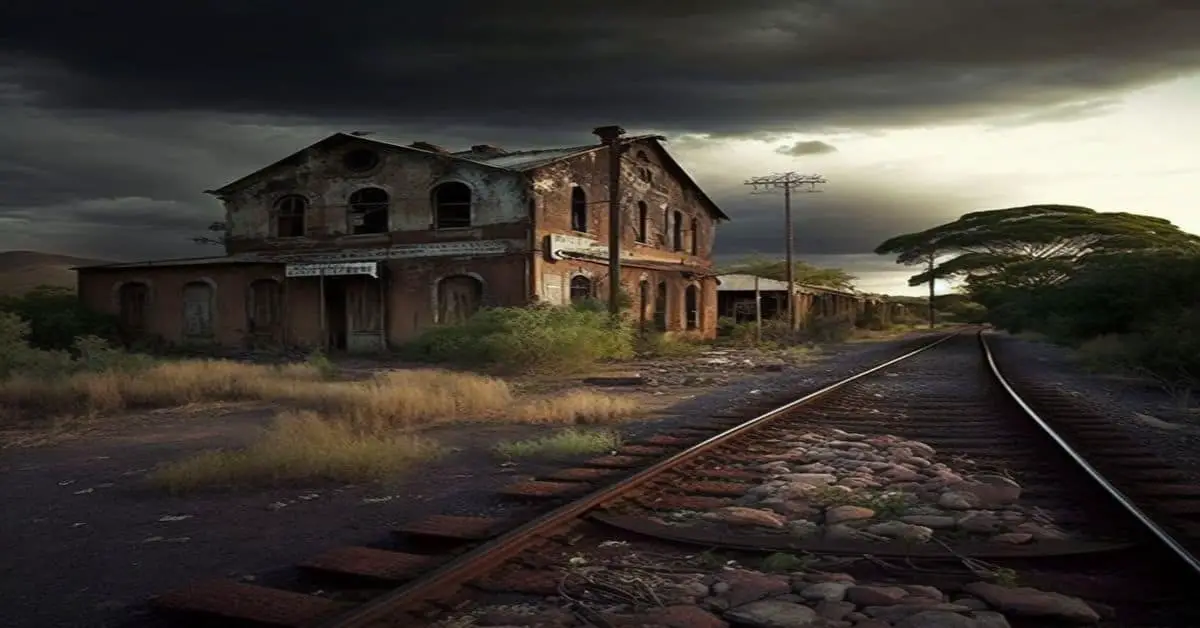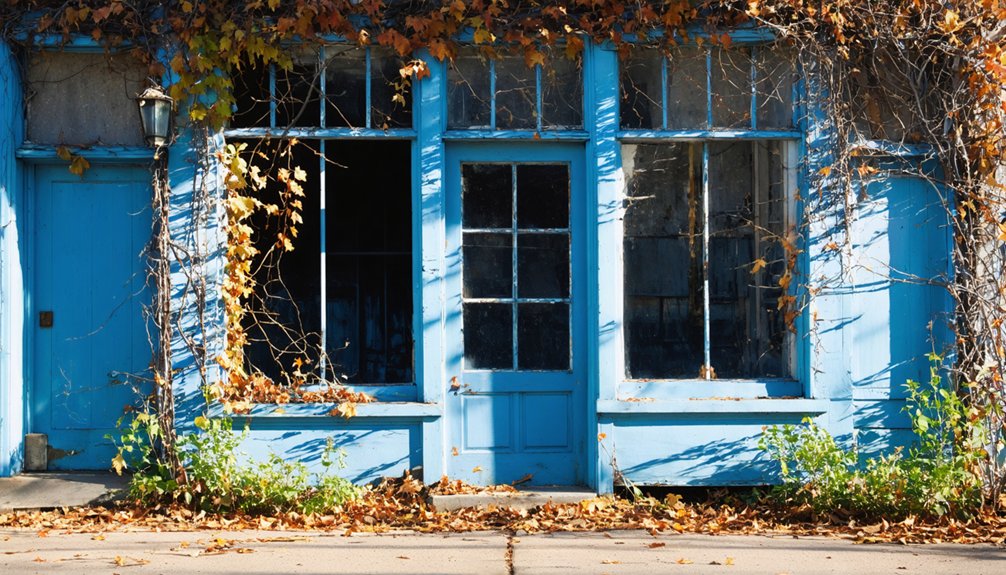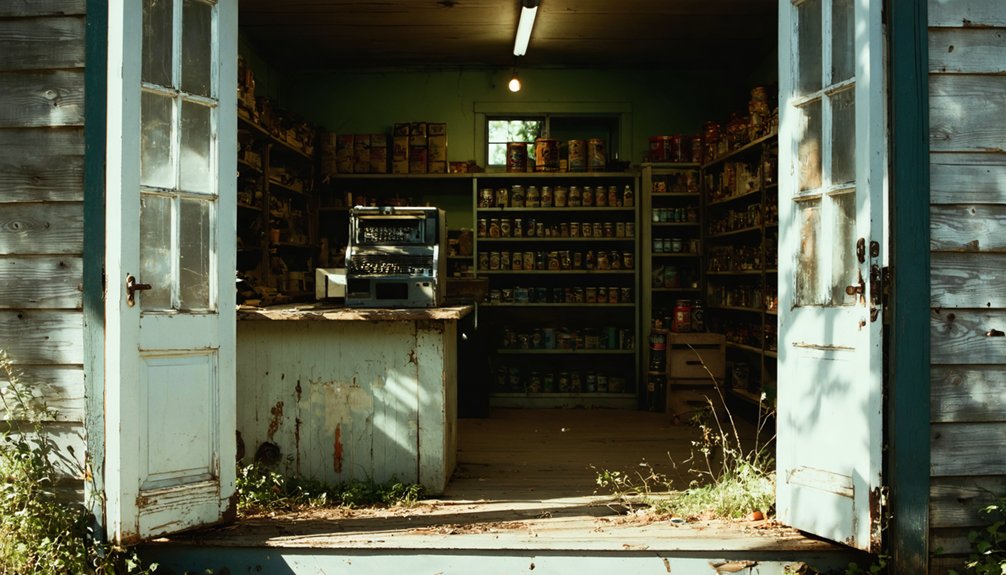You’ll find Owens Station at the intersection of Beach Highway and Owens Road in Sussex County, Delaware – a ghost town that once thrived as a Queen Anne’s Railroad stop. From 1900-1925, this small but essential community grew from 18 to 62 residents, serving as a significant link between Ellendale and Greenwood. Today, only a handful of weathered houses remain as silent witnesses to the town’s railroad heritage, each crumbling structure holding untold stories of Delaware’s transportation past.
Key Takeaways
- Owens Station emerged as a railroad stop along the Queen Anne’s Railroad line, growing from 18 to 62 residents between 1900-1925.
- The settlement’s decline followed the Queen Anne’s Railroad’s downfall, leading to the dispersal of its railroad worker population.
- Today, only a few original houses remain at the intersection of Beach Highway and Owens Road.
- Commercial and community buildings have disappeared, with nature reclaiming much of the former settlement area.
- The ghost town serves as a remnant of Delaware’s railroad heritage, with remaining structures deteriorating without preservation efforts.
The Rise and Fall of a Railroad Settlement
As Delaware’s railroad network expanded in the mid-19th century, Owens Station emerged as a small but essential stop along the Queen Anne’s Railroad line between Ellendale and Greenwood.
You’d have found this Sussex County settlement, perched at 52 feet elevation, growing steadily as railroad expansion brought new opportunities. The population climbed from 18 residents in 1900 to 62 by 1925, reflecting the community’s rising fortunes.
The railroad’s presence transformed local life, connecting farmers and manufacturers to broader markets while fostering community dynamics centered on the station’s activities. Today, only a few houses remain at the intersection of Beach Highway and Owens Road.
The area experienced the same fate as many other rail communities, as Delaware saw a gradual decline in rail lines over the last five decades, particularly in agricultural regions.
However, when the Queen Anne’s Railroad eventually closed and its tracks were removed, Owens Station’s fate was sealed. The land reverted to private owners, and the once-thriving railroad town faded into an unincorporated area.
Life Along the Queen Anne’s Railroad
While the Queen Anne’s Railroad primarily served as an essential transportation artery between Love Point, Maryland, and Lewes, Delaware, it transformed daily life across the Delmarva Peninsula through its extensive network of connections.
Following legislative authorization from Delaware in 1895, the railroad began expanding its reach across state lines. You’d find bustling stations in towns like Milton, where locals shipped holly to northern cities and welcomed the first passenger trains with celebration. Railroad tourism flourished as you could hop on the Cape May Express from Queenstown, transfer to a steamship at Lewes’ impressive 1,202-foot Queen Anne Pier, and reach New Jersey’s coastal resorts.
Maritime commerce thrived at the pier, where you’d see everything from fishing vessels to pilot boats. The Maryland, Delaware and Virginia railroad company took control of operations in 1905.
But harsh winters, the devastating 1904 Baltimore fire, and mounting financial losses eventually led to the railroad’s decline and ultimate abandonment by the 1930s.
Historical Population and Demographics
During its peak years, Owens Station maintained a modest but growing population, expanding from just 18 residents in 1900 to 62 by 1925.
You’ll find that population trends closely followed the fortunes of the Queen Anne’s Railroad, with most residents being railroad workers and their families who settled near the tracks.
The demographic shifts that shaped this small community reflected its role as a minor railroad stop.
Today, evidence of the former community can still be found at the intersection of Beach Highway and Owens.
You won’t find records of extensive public amenities or municipal services, as the unincorporated settlement consisted mainly of simple houses clustered around the rail line.
When the railroad ceased operations, the population scattered quickly, and former railroad lands reverted to their original owners.
Compared to thriving nearby towns like Greenwood and Ellendale, Owens Station remained significantly small throughout its brief existence.
What Remains Today: A Ghost Town’s Legacy
Today you’ll find only scattered remnants of Owens Station at the intersection of Beach Highway and Owens Road, where a handful of original houses stand as silent witnesses to the town’s railroad past.
The once-bustling railroad stop has succumbed to urban decay, with most commercial and community buildings vanishing entirely. Abandoned lovely houses remain as testaments to the town’s prosperous era. Located on the Queen Annes RR line between Ellendale and Greenwood, the station played a vital role in regional transportation. Nature has reclaimed vast portions of the settlement, while surviving structures slowly deteriorate without preservation efforts.
The site’s cultural memory lives on primarily through the Owens Station Hunting Preserve, which bears the town’s name.
You won’t find any historical markers or tourism infrastructure here – just rural farmland and scattered homes. While the railroad tracks have been removed and time continues its steady erosion, these remaining traces offer glimpses into Delaware’s vanishing railroad heritage.
Preserving Delaware’s Railroad Heritage
As Delaware’s railroad heritage faces mounting preservation challenges, several dedicated organizations work tirelessly to protect and celebrate the state’s rich rail history. The 124-mile system between Pennsylvania and New York revolutionized coal transport through the region.
You’ll find groups like the Delaware & Hudson Transportation Heritage Council and the Iron Horse Society leading railroad preservation efforts through active community engagement initiatives. The Delaware General Assembly played a crucial role in establishing the state’s first railroad charters in 1836.
- The Delaware & Hudson Railway Historical Society maintains essential archives of maps, documents, and artifacts.
- Local heritage groups operate museums like Delmar’s caboose museum and Laurel’s Train Station Museum.
- Model railroad clubs host open houses and holiday events to connect communities with their rail heritage.
- Restored historic stations serve as education centers, offering free public access to Delaware’s transportation past.
These preservation efforts help maintain your connection to the cultural identity that railroads helped forge throughout Delaware’s development.
Frequently Asked Questions
Are There Any Paranormal Activities Reported in the Remaining Houses?
You won’t find documented ghost sightings or paranormal activities in these houses. Unlike Delaware’s established haunted locations, there’s no verified evidence of supernatural phenomena at the remaining Owens Station structures.
What Happened to the Families Who Lived There After Leaving?
Like the Johnson family who might’ve moved to Dover, you won’t find clear family histories. Most residents scattered to nearby towns, following typical rural migration patterns of seeking better economic opportunities.
Can Visitors Legally Explore the Remaining Structures at Owens Station?
You can’t legally explore Owens Station’s structures without explicit landowner permissions. All remaining buildings are on private property, and trespassing laws strictly prohibit unauthorized exploration of these sites.
Were There Any Notable Businesses Besides the Railroad Station?
Like a one-horse town, you won’t find any historic landmarks or local legends about notable businesses here. Records show the railroad station was the only documented commercial enterprise in this area.
What Native Plants and Wildlife Can Be Found in Owens Today?
You’ll find native flora like switchgrass, redcedar, and loblolly pine thriving alongside wildlife species including white-tailed deer, eastern cottontails, red foxes, and various wetland-dwelling amphibians in Owens’ diverse habitats.
References
- https://en.wikipedia.org/wiki/Owens_Station
- https://everything.explained.today/Owens_Station
- https://usabynumbers.com/ghost-towns-in-delaware/
- https://www.ghosttowns.com/states/de/owensstation.html
- https://www.onlyinyourstate.com/experiences/delaware/abandoned-places-delaware
- https://archives.delaware.gov/delaware-historical-markers/coming-of-the-railroad/
- https://kids.kiddle.co/Owens_Station
- https://www.american-rails.com/de.html
- https://www.theinfolist.com/html/ALL/l/O/Owens_Station
- https://www.wikiwand.com/en/articles/Owens_Station



